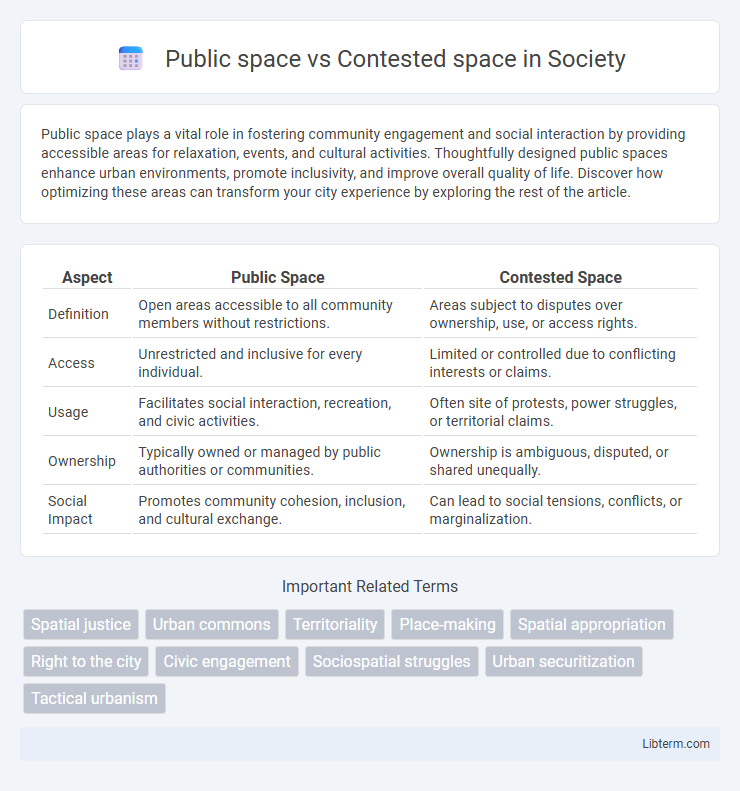Public space plays a vital role in fostering community engagement and social interaction by providing accessible areas for relaxation, events, and cultural activities. Thoughtfully designed public spaces enhance urban environments, promote inclusivity, and improve overall quality of life. Discover how optimizing these areas can transform your city experience by exploring the rest of the article.
Table of Comparison
| Aspect | Public Space | Contested Space |
|---|---|---|
| Definition | Open areas accessible to all community members without restrictions. | Areas subject to disputes over ownership, use, or access rights. |
| Access | Unrestricted and inclusive for every individual. | Limited or controlled due to conflicting interests or claims. |
| Usage | Facilitates social interaction, recreation, and civic activities. | Often site of protests, power struggles, or territorial claims. |
| Ownership | Typically owned or managed by public authorities or communities. | Ownership is ambiguous, disputed, or shared unequally. |
| Social Impact | Promotes community cohesion, inclusion, and cultural exchange. | Can lead to social tensions, conflicts, or marginalization. |
Understanding Public Space: Definition and Importance
Public space refers to areas such as parks, plazas, streets, and squares that are open and accessible to all individuals regardless of social or economic status. Contested space emerges when differing groups dispute control, access, or meaning of these public areas, often reflecting broader social, political, or cultural conflicts. Understanding public space highlights its critical role in fostering community interaction, democratic expression, and social inclusion, making it essential for vibrant urban life.
Contested Space: Meaning and Dynamics
Contested space refers to areas where control, access, or symbolic meaning is disputed by different social, political, or cultural groups, leading to ongoing conflicts and negotiations. These spaces are characterized by overlapping claims, dynamic interactions, and power struggles that reflect broader societal tensions, often manifesting in protests, territorial disputes, or contestations over urban development. Understanding the dynamics of contested space requires analyzing the roles of actors, spatial practices, and underlying issues such as inequality, identity, and governance.
Historical Perspectives on Public and Contested Spaces
Historical perspectives on public and contested spaces reveal how these areas have evolved as arenas for social, political, and cultural expression. Public spaces, such as town squares and marketplaces, historically functioned as essential sites for communal interaction and civic engagement, while contested spaces emerged through struggles over ownership, identity, and power dynamics. Key events like the Civil Rights Movement and decolonization processes illustrate how contested spaces become symbols of resistance and transformation within urban landscapes.
Urban Design and the Shaping of Public Spaces
Public space in urban design refers to areas intentionally designed for communal use, fostering social interaction, inclusivity, and accessibility. Contested space emerges when these areas become sites of conflict over usage rights, cultural identity, or political expression, challenging the intended openness of urban landscapes. The shaping of public spaces involves balancing design elements that accommodate diverse activities while mitigating disputes to ensure equitable community engagement and spatial justice.
Political Power in Contested Spaces
Contested spaces are arenas where political power is actively negotiated and challenged, often reflecting underlying conflicts between different social groups or ideologies. These spaces serve as critical sites for asserting dominance, resistance, and claims to legitimacy by political actors striving to influence governance and public policy. The dynamics within contested spaces reveal the complexity of power relations and the struggle to define who controls and represents the social order.
Social Movements and Occupation of Public Spaces
Social movements leverage public spaces as critical venues for collective expression, activism, and visibility, transforming everyday urban areas into focal points for political engagement. Contested spaces arise when authorities, communities, or opposing groups dispute the legitimacy and control of these areas, often leading to confrontations during occupations by protesters. Occupation of public spaces symbolizes resistance and the demand for social change, highlighting tensions between state power and civil society in shaping urban governance and democratic participation.
Accessibility and Inclusivity in Public Space
Public spaces are designed to be accessible and inclusive, promoting community engagement by accommodating diverse populations including people with disabilities, different ages, and cultural backgrounds. Contested spaces often arise when access is restricted or controlled, leading to social exclusion or conflicts over who can use or benefit from the area. Designing for accessibility with universal design principles and inclusive policies ensures public spaces serve as equitable environments that foster social cohesion and participation.
Surveillance, Security, and Public Space Control
Surveillance technologies in public spaces are increasingly utilized to enhance security but often blur the boundaries between public freedom and state control, turning these zones into contested spaces. The deployment of CCTV cameras, facial recognition, and data analytics enables authorities to monitor behaviors, raising concerns about privacy infringement and social inequality. Control over public spaces through surveillance mechanisms transforms them into instruments of power where access and expression are regulated rather than freely exercised.
Art, Expression, and Ownership in Contested Spaces
Contested spaces often become dynamic arenas where art and expression challenge traditional notions of ownership and control, transforming public spaces into sites of political and social negotiation. Graffiti, murals, and performance art in these areas serve not only as creative outlets but also as powerful tools for marginalized communities to assert identity and resist dominant narratives. The tension between public accessibility and contested ownership underscores the ongoing struggle over who has the right to shape and define shared environments through artistic expression.
Future Trends: Reimagining Public and Contested Spaces
Emerging future trends emphasize transforming public and contested spaces through innovative urban design and technology integration, prioritizing inclusivity, accessibility, and community engagement. Smart infrastructure and augmented reality tools enable dynamic interactions within these spaces, fostering collaborative conflict resolution and cultural expression. Sustainable development and adaptive reuse strategies promote resilience and multifunctionality, reshaping contested areas into shared environments that reflect diverse social identities and evolving urban needs.
Public space Infographic

 libterm.com
libterm.com